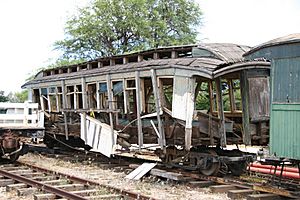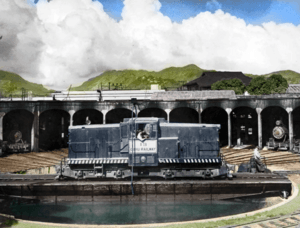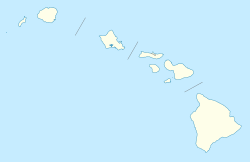Oahu Railway and Land Company facts for kids
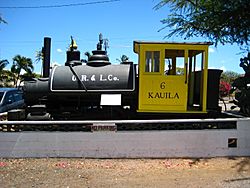
OR&L No. 6, the Oahu Railway's first locomotive, at the Hawaiian Railway Society
|
|
| Overview | |
|---|---|
| Headquarters | Honolulu, Hawaii |
| Dates of operation | 1889–1971 |
| Technical | |
| Track gauge | 3 ft (914 mm) |
The Oahu Railway and Land Company, often called OR&L, was a special type of railway on the Hawaiian island of Oahu. It was a 3 ft (914 mm) narrow gauge railway, meaning its tracks were closer together than standard tracks. The OR&L was the biggest narrow gauge railway of its kind in the U.S. It served most of Oahu until it closed down in 1947.
Contents
How the OR&L Started
The OR&L was created by Benjamin Dillingham. He was a self-made businessman who came to Honolulu as a sailor in 1865. After an accident where he broke his leg, Dillingham had to stay in Hawaii. He decided to make it his home. Benjamin Dillingham was very good at business. He soon became rich and important in the early Honolulu community.
In the 1870s, Dillingham thought the dry ʻEwa Plain would be a great place for people to live. But there were two big problems. First, there wasn't enough water. Second, it was hard to get around. Traveling from Honolulu to ʻEwa by horse-drawn wagon took a whole day! Dillingham realized a railroad was the answer.
Around the same time, another businessman named James Campbell found a way to get water. In 1879, he successfully dug ʻEwa's first artesian well. This solved the water problem. Campbell had bought 40,000 acres (16,200 ha) of land in ʻEwa. He first thought about starting a cattle ranch. But he soon saw that ʻEwa's rich soil, sunny weather, and new water supply were perfect for growing sugarcane. Within a few years, sugarcane plantations began to grow in this part of Oahu. The need for a way to move goods between the harbor and ʻEwa became very important.
Building the Railway
While Dillingham's dream of many people settling on the ʻEwa Plain took longer, his plan for a railroad happened quickly. He rented land from James Campbell in ʻEwa and Kahuku to start two sugarcane plantations. On September 11, 1888, he got a special railroad permit from King David Kalākaua.
After getting the money, Dillingham started building in March 1889. His goal was to connect Honolulu and ʻAiea, a distance of 12 miles (19 km), by the fall of 1889. On November 16, 1889, which was the king's birthday, the OR&L officially opened. More than 4,000 curious people got to ride for free!
By 1892, the railway line was 18.5 miles (29.8 km) long. It reached the ʻEwa sugar mill, which was part of Dillingham's ʻEwa Plantation Company. Even though progress slowed down during a time of change in Hawaii, by 1895 the railroad had passed through Waipahu. It crossed the ʻEwa plain and went along the Waiʻanae coast to another sugar mill. In January 1897, the company got more money. They extended the railroad around Oahu's rough Kaʻena Point to Haleiwa on the north shore by June 1897. Dillingham even built a hotel there.
By December 1898, the main line was finished. It stretched past Waimea Bay and Sunset Beach all the way to Kahuku. This was past the island's northernmost tip, reaching the Kahuku sugar mill. There was talk of a railway that would go all the way around the island, but it never happened. In 1906, an 11-mile (18 km) branch line was built from Waipahu. It went up the Waikakalua Gulch to Wahiawa and the pineapple fields in central Oahu. This was the final shape of the railroad.
OR&L Before World War II
The OR&L was more than just a sugarcane railway. It served several sugar mills and plantations, moving their products, equipment, and workers. Sometimes, the sugarcane plantations had their own smaller railway lines. As a "common carrier," the OR&L carried all sorts of things. This included freight (goods), passengers, mail, and packages.
For example, besides sugar and pineapples, the railroad moved garbage from Honolulu to a dump on the Waiʻanae Coast. It also carried sand from Waiʻanae to Honolulu when Waikiki was being developed. The railway also served major military bases like Pearl Harbor, Hickam Field, Barber's Point Naval Air Station, Schofield Barracks, and Wheeler Army Airfield.
In 1926, Dillingham built a new station for passengers. It was designed by Bertram Grosvenor Goodhue, a very famous architect. He also designed the Honolulu Museum of Art and the C. Brewer Building. The station was built in a Spanish Mission Revival style, similar to many other public buildings from that time. After 1947, the OR&L train station became a bus terminal. It was added to the National Register of Historic Places in 1979 because of its historical importance.
The railroad made money, even during the Great Depression (a time when many businesses struggled). It was a very important way to communicate and travel until the 1930s. Just like with railroads on the mainland, more private cars and public roads led to fewer people using the trains. This was especially true for passengers. As World War II approached, the OR&L almost stopped carrying passengers. It focused on its profitable freight operations instead.
OR&L During World War II
World War II was probably the most important time for the OR&L. But it also led to the company's end. After the attack on Pearl Harbor on December 7, 1941, the OR&L became a huge part of wartime transportation. The railroad continued its regular freight services. It also handled massive amounts of military-related traffic.
The OR&L became the main way to transport civilian workers, sailors, soldiers, airmen, and marines. It took them from Honolulu to their bases, or from bases back to Honolulu for much-needed rest and relaxation. In 1944 and 1945, the OR&L carried almost two million riders!
The End of the Line
|
Oahu Railway and Land Company
Right-of-Way |
|
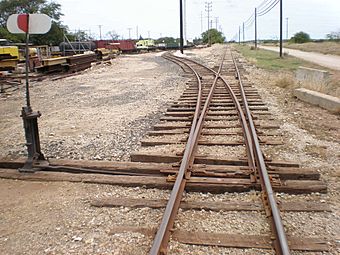
A portion of the track is preserved
|
|
| Nearest city | Nanakuli, Hawaii |
|---|---|
| Area | 63 acres (25 ha) |
| Built | 1889 |
| Architectural style | 3 ft (914 mm) narrow gauge railroad track |
| NRHP reference No. | 75000621 |
| Added to NRHP | December 1, 1975 |
By the end of the war, most of the trains, tracks, and buildings were worn out. The company's leaders wondered if they should keep going. When the war ended, the huge amount of wartime traffic stopped. Also, Oahu's roads had been greatly improved. For the first time, there was serious competition from road transport.
The company kept going through the rest of 1945 and into 1946, transporting servicemen. However, passenger numbers and money earned dropped by more than half. The railroad's fate was sealed by the 1946 Aleutian Islands earthquake. This earthquake caused a 55-foot (17 m) tsunami that hit on April 1, 1946.
Many historians overlook another important event. From September 1 to November 18, 1946, 22,000 sugar workers went on strike. This happened at 33 of Hawaii's 34 sugarcane plantations. Only one plantation on Kauai kept working. The strike had a big impact on Hawaii. The OR&L's freight business dropped to very low levels.
Even though the OR&L rebuilt the tracks destroyed by the tsunami and kept working during the strike, the decision was made to close the entire operation at the end of that year. On December 31, 1947, a final special trip took place. Company President Walter F. Dillingham (Benjamin Dillingham's son) and many guests rode from Kahuku. They traveled behind American Locomotive Company steam engine number 70. They went through 71.4 miles (114.9 km) of countryside back to the Honolulu station. The OR&L was finished after fifty-eight years. The company then replaced its railway with a truck transport business.
Most of the railway system was taken apart in the years after it closed. However, the double-tracked main line from Honolulu to ʻAiea stayed until about 1959. Four of the locomotives, 250 freight cars, and a lot of track and supplies were sold to a railway in El Salvador in 1950. A group of local train fans formed the Hibiscus & Heliconia Short Line Railroad (H&HSL RR) in 1948. Ben Dillingham gave the group a first-class coach #47 and an observation car #48, which used to be his private car called Pearl.
The Kahuku Plantation Co. let the group use their tracks from near Kawela Bay to Punaluu. The group ran special trips sometimes, renting a steam locomotive from Kahuku Plantation. In 1950, the last steam locomotive was retired. The H&HSL RR then used one of two old Navy diesel engines. In 1954, the plantation stopped using its railroad and switched to trucks. This ended the H&HSL RR. The group didn't have enough money or interest to move their two coaches from the property, so a plantation official had them burned.
The OR&L's Honolulu harbor branch, renamed the Oahu Railway, was used until December 31, 1971. It was used for industrial operations. It served a Kalihi stockyard until 1961. But mainly, it carried incoming Molokai pineapples from the docks to the Libby, McNeil and Libby and California Packing Corporation (Del Monte) canning plants. The last part of the line was taken over by the US Navy in 1950.
The Navy, especially during the Korean War and the Vietnam War, ran ammunition trains. These trains went between the West Loch of the Pearl Harbor Naval Base, through the ʻEwa Plain, to the Lualualei Naval Ammunition Depot on the Waiʻanae coast. This kept one of the most famous and beautiful parts of the railroad working. The Navy switched to trucks, and the railroad property was abandoned in 1970.
The Oahu Railway & Land Company later joined with Hawaiian Dredging to form Dillingham.
Saving History
In 1970, a small group of railroad fans on Oahu heard that the line was being abandoned. They asked the Navy to give them the line and its equipment. This group became the Hawaiian Railway Society (HRS) in 1970. Nicholas Carter, one of the founders of the HRS, worked with others in the early 1970s. They suggested that the old OR&L main line from ʻEwa to Nānākuli be added to the National Register of Historic Places. On December 1, 1975, U.S. Senator Hiram Fong announced that it had been done.
Today, the tracks are owned by the State of Hawaii. The HRS is in charge of taking care of the line. The HRS continues to maintain and extend the tracks. They also run special train trips from their station in ʻEwa. Currently, trains run on Saturday afternoons at 3:00 PM and Sunday afternoons at 1:00 PM and 3:00 PM. They go past the new city of Kapolei, through the Koʻolina golf resort, and up the Waiʻanae Coast. Right now, they only go as far as Kahe Point. However, the tracks east of Fort Weaver Road have been removed. So, trains can only run on the line west of that point.
Besides the old Army flat cars used to carry passengers, three other cars are at the Hawaiian Railway Society. These are Coach #2, excursion car #57, and Benjamin Franklin Dillingham's private coach, parlor car #64.
Three cars are also at the Travel Town Museum in Griffith Park, California. Coach #1, combination car #36, and caboose #1 were all built around 1900 at the OR&L shops. They were given to the museum by the OR&L in 1953.
Two diesel locomotives, GE 44-ton switchers numbered 15 and 19, are still used regularly on the Cumbres and Toltec Scenic Railroad.
Images for kids
- Historic American Engineering Record (HAER) No. HI-91, "Oahu Railway & Land Company Trestle Ruins, Spanning Makaha Stream between Makaha Beach & Farrington Highway, near Kili Drive, Honolulu, Honolulu County, HI", 4 photos, 10 data pages, 1 photo caption page


